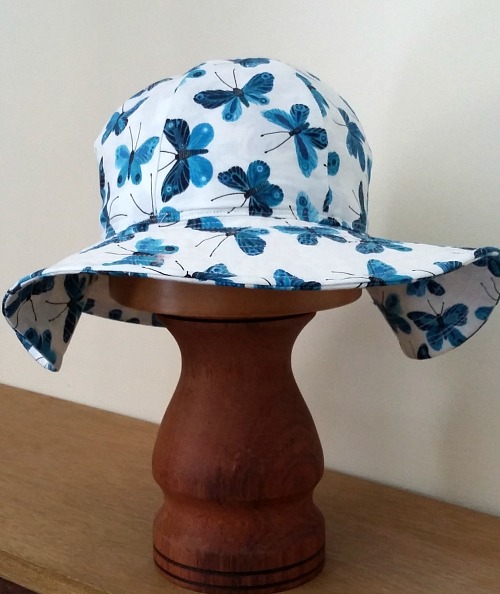Although I can't remember which book or books I read this trick in, it appeared when I needed it, which is what matters.
I do a lot of blocked hats, that are steamed or wet and shaped over a hat block, usually out of felt or straw. Sometimes I make sewn hats too, but they are usually berets or other styles that don't follow the shape of the head. So it was only when working on a couple of toddler hats, with a self-drafted and not that great pattern, that I remembered that you can also block these hats, after sewing.
Basically, after sewing together the pieces of a sectional crown, like on this sun hat, you wet the fabric (or steam it, whichever is appropriate for the fabric) pull it down over a hat block, and leave it to dry (keeping in place with an elastic band if necessary). It helps smooth out any issues with an imperfect pattern, and gives a really rounded look to the end product. Depending on your fabric type, the results will vary.
The first hat I tried it on was this pink fleece pig hat (photo courtesy of @herohappymail on Instagram - a great project, by the way, supporting kids that are having a rough time for various reasons). I've improved my pattern since then, but the fleece was so stretchy and obliging that I managed a really round crown despite any issues in the shape as originally sewn.
When I went to regular cotton, the fabric was not so forgiving. It was actually a great way to work on the pattern though, because the blocking really showed exactly where the lines needed to be changed. I ended up using the first version as the lining and the adjusted pattern to make the outside crown.
So you do need something to block on, and I don't recommend using your own head unless you want to wear a wet hat all day. Hat blocks are of course great, but foam display heads are a possibility (although they are often quite small).
 |
| No cameras! I'm covered in risotto! |
I'm really glad I remembered, and finally tried, this little trick, and I'm sure I'll find ways to use it again. Maybe it will stick in your brain until you one day need it too!






